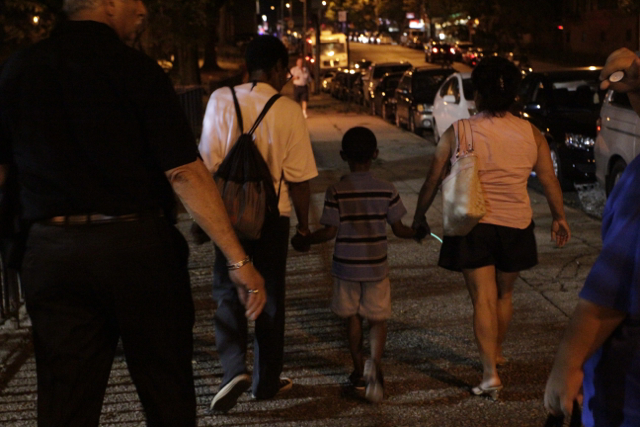
Residents of the Pelham Parkway Houses participate in a candlelight vigil and crime-prevention event. (MARGARET BADORE / The Bronx Ink)
In August, Adrian Garcia, 25, was shot and killed in the Pelham Parkway Houses in the Bronx. Two months earlier, 88-year old Evelyn Shapiro was bludgeoned to death inside her apartment in the public housing project, which was until recently relatively peaceful.
Both cases are still unsolved, leaving some residents fearful and others angry enough to act.
“Every week this summer there’s been some type of violence in my development,” said Herma Williams, who was Shapiro’s neighbor for many years.
Williams is in the process of organizing a residents’ watch for the 23-building complex that houses 2,500 people. She does not want to wait for the New York City Housing Authority (NYCHA) to install security cameras it has promised for next year. “I don’t need to wait for somebody else to come in and say, ‘This is what you need to do in your community,’ ” said Williams, who has served as the project’s tenant president for 19 years.
The number of violent crimes at Pelham Parkway Houses and its surrounding neighborhood are up in 2012 according to data for the 49th precinct. Seven murders were recorded in the precinct so far this year, up from three in 2011. Armed assaults are up 13.3 percent from the previous year.
Longtime residents described growing up in the Pelham Parkway Houses when it was possible for kids to sit on the benches in the center of the complex’s buildings talking with friends until 1 or 2 a.m. “Now, I wouldn’t sit there at 1 o’clock in the afternoon,” Cathy Kiler, 50, said.
Yvonne Lewis, who has lived in the Pelham Parkway Houses for 18 years, said the violence made her consider moving, but adds that she thinks a residents’ patrol could make a difference. “I would even participate sometimes,” she said. “I think that would help.”
The residents’ watch would be a volunteer effort to encourage neighbors to look out for one another. NYCHA offers resources to facilitate the volunteer resident watch program. “They do outreach, they do recruitment and they provide the training,” explained Williams.
Housing authority regulations require that able-bodied residents do eight hours a month of community service. Participating in the watch could be one way to fulfill that requirement. Once a coordinator is hired and details finalized, residents would likely be asked sit in their lobbies of buildings, stroll through their halls and report suspicious activity to the 49th precinct.
Since the first murder in June, police patrols have increased around the housing development, but Williams hopes that residents who work as corrections officers, school safety officers and security guards will volunteer. “We look to them as professionals in law-enforcement.”
On Friday, September 7, the residents council organized a candlelight vigil for the victims and served as a prelude to the watch program. A group of residents, uniformed police officers, and supporters from the surrounding neighborhood gathered at the location of Garcia’s death to send a message that crime will not be ignored. “It impacts the good members of the community and the not so good members of the community,” said Police Captain Andy Johnson.
Inspired by the Occupy the Street Corners anti-violence movement that originated in Harlem, the group of about 30 adults and 15 children made a circuit around the housing project. “Take back your community!” shouted Williams, addressing residents still inside with a megaphone. “What you see tonight is just the beginning.”

